Executive summary
Explore the transformative world of Contact Center as a Service (CCaaS) in this comprehensive guide, which illuminates its pivotal features, implementation strategies, and various benefits. Uncover how CCaaS streamlines operations, fosters exceptional customer experiences, and gives businesses the agility to scale, underscoring its significance in today’s digital-first customer service landscape.
In a world where instant and effective communication reigns supreme, Contact Center as a Service (CCaaS) stands out as a beacon for businesses striving to elevate their customer service game. It isn’t just about taking calls; it’s about crafting experiences that resonate with customers, offering them the convenience and care they demand. CCaaS is the secret sauce for businesses looking to thrive in the digital age, providing a versatile platform that marries the latest tech with customer-centric service.
Gone are the days of one-dimensional call centers. Today, CCaaS introduces a realm where AI subtly enhances interactions, making every customer feel understood and valued. This blog will walk you through the CCaaS landscape, showing how it’s an upgrade and a necessity for businesses aiming to deliver standout service in an ever-connected world.
Related must-reads:
- Contact center services: Types, benefits and tips for managing
- What are the benefits of contact center AI?
- Omnichannel contact center: A guide for managers
- Contact Center Automation: Benefits, Types and Examples
What is Contact Center as a Service (CCaaS)?
Contact Center as a Service (CCaaS) transforms how businesses handle customer interactions. It’s a cloud-based solution offering contact center capabilities on a subscription basis. This model lets companies manage calls, emails, chats, and social media interactions without needing on-premise infrastructure.
CCaaS stands out for its flexibility and scalability. It allows businesses to adjust their customer service resources based on demand, eliminating the need for heavy upfront investment in technology and hardware. With CCaaS, updates and new features are seamlessly integrated, ensuring that organizations always have access to the latest customer service technology.
This service model is pivotal for businesses aiming to provide consistent and efficient customer support across multiple channels. Projections show that the worldwide contact center as a service (CCaaS) market will reach USD 17.12 billion by 2030, expanding at a CAGR of 19.1% from 2023 to 2030. Besides simplifying operations, CCaaS also harnesses data analytics to enhance customer interactions, leading to improved satisfaction and loyalty. It’s a strategic choice for companies focusing on customer-centric growth in today’s digital landscape.
Key CCaaS features and capabilities
Contact Center as a Service (CCaaS) melds cutting-edge technology with customer service, offering businesses a suite of features to streamline operations and enhance customer engagement. Here’s how these features and capabilities stand out:
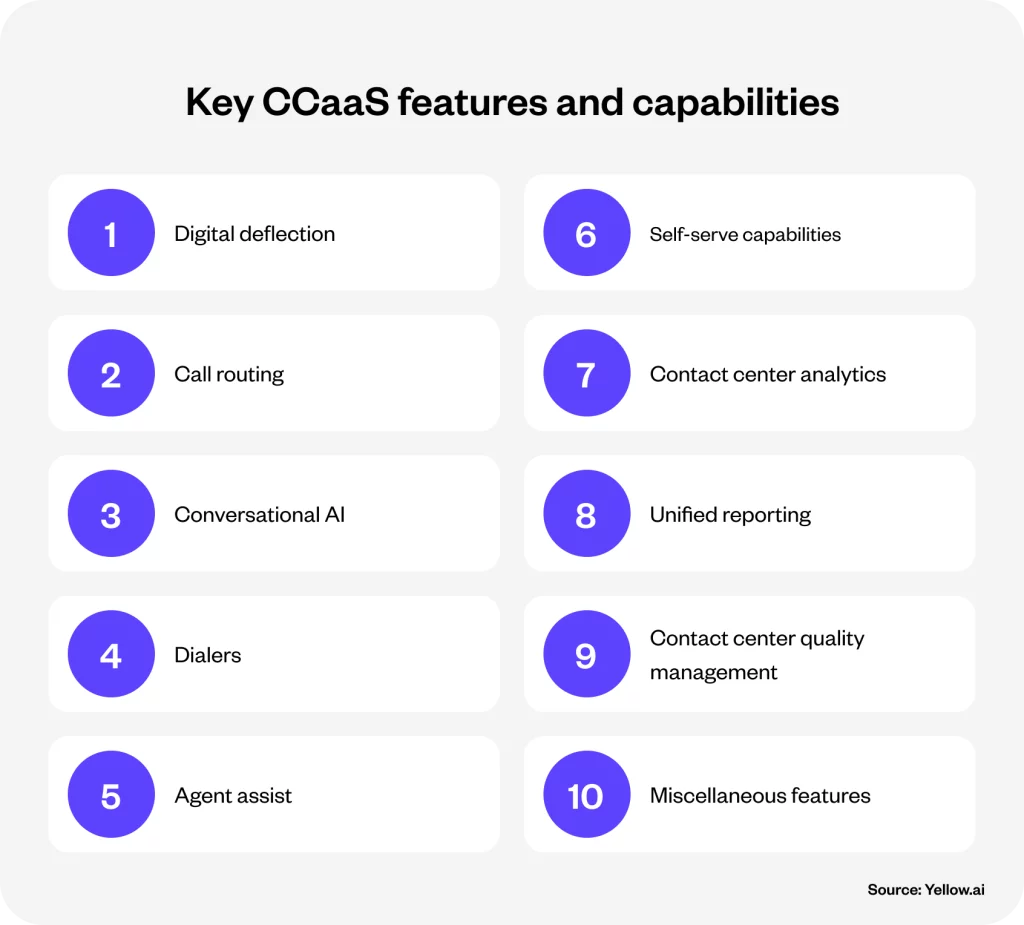
Related read: 7 Proven Strategies to Improve Customer Engagement!
1. Digital deflection
This feature intelligently redirects voice calls to digital channels like chat or messaging, easing the call load on agents. It’s a strategic move to manage high call volumes efficiently while offering customers quicker, more convenient service options.
Key benefits:
- Reduces call volume and wait times.
- Enhances customer experience with immediate, alternative support options.
- Minimizes agent workload, preventing burnout.
2. Call routing
Intelligent call routing is essential for directing calls to the right agent based on specific criteria. It ensures customers connect with the most suitable representative quickly.
Key tools:
- Interactive Voice Response (IVR): Guides callers through a menu to self-route or reach the right department.
- Automated Call Distribution (ACD): Manages inbound calls, distributing them to agents based on predefined rules.
Key benefits:
- Personalizes customer service by matching inquiries with the best-suited agents.
- Optimizes resource allocation and improves service speed.
3. Conversational AI
This feature employs artificial intelligence for natural interactions. It enhances self-service and agent support through smart communication.
Related read: What is conversational AI? – Benefits and Examples
Key tools:
- Voice bots: Engage customers in voice interactions, providing a hands-free support experience.
- Chatbots: Offer instant text-based answers to customer queries, improving response times.
Key benefits:
- Frees up agents for more complex and high-value interactions.
- Enhances customer satisfaction through quick and accurate responses.
4. Dialers
Outbound dialing systems in CCaaS can proactively reach out to customers. It helps support sales, feedback, and engagement initiatives.
Key tools:
- Predictive dialers: Automate the calling process by predicting the best times to connect with customers, maximizing agent productivity.
Key benefits:
- Automates call processes for telemarketing and customer outreach.
- Utilizes predictive dialing to optimize call schedules and reduce idle time.
- Boosts sales opportunities and maintains customer relationships.
5. Agent assist
The agent assist capability of CCaaS provides agents with real-time assistance. It supplies information and suggestions during customer interactions.
Key tools:
- Knowledge bases: Provide agents with quick access to information, helping them answer customer queries effectively.
- Real-time analytics: Offer insights during calls to aid decision-making and personalize customer interactions.
Key benefits:
- Incorporates tools for quick actions and smart comprehension.
- Reduces response times and enhances the quality of customer service.
- Supports agents in delivering efficient and informed resolutions.
6. Self-serve capabilities
CCaaS allows customers to find solutions independently. That reduces the pressure on contact center resources.
Related read: Benefits of customer self-service
Key tools:
- Self-service portals: Online platforms where customers can access FAQs, troubleshooting guides, and account management options.
- Interactive FAQs: Dynamic FAQ sections that use AI to predict and answer common customer inquiries.
Key benefits:
- Integrates FAQ chatbots and knowledge bases for self-help options.
- Encourages customer autonomy and quick problem-solving.
- Reduces inbound query volume, allowing agents to focus on complex cases.
7. Contact center analytics
They leverage data from customer interactions to inform strategic decisions and operational improvements. The data analytics platforms aggregate and analyze customer interaction data across channels to identify trends and operational opportunities.
Related read: Contact center analytics: Importance and best practices
Key benefits:
- Provide insights into customer behavior and service trends.
- Identify areas for enhancement in customer service strategies.
- Drive continuous improvement based on analytical evidence.
8. Unified reporting
CCaaS offers a comprehensive view of data and metrics to assess performance and inform business strategies. For example, dashboard software visualizes data in real-time, allowing for immediate assessment and action.
Key benefits:
- Facilitates in-depth analysis with customized reports for different organizational levels.
- Enhances decision-making with accessible and actionable insights.
- Supports transparency and accountability within the contact center operations.
9. Contact center quality management
CCaaS monitors and evaluates agent performance to ensure high service standards and identify training needs. It works as a quality monitoring software that records and assesses agent-customer interactions to ensure service standards are met.
Key benefits:
- Benchmarks performance for consistent quality assurance.
- Allows for targeted coaching and skill development.
- Enhances overall service quality and customer satisfaction.
10. Miscellaneous features
CCaaS solutions integrate seamlessly with existing systems and maintain high compliance and security standards.
Key tools:
- Integration platforms: Connect CCaaS with CRM, ERP, and other business systems for a unified operation.
- Security measures: Implement encryption, access controls, and data protection standards to safeguard customer information.
Key benefits:
- Ensures smooth operations with robust integration capabilities.
- Protects customer data and adheres to regulatory requirements.
- Fosters a secure and reliable environment for customer interactions.
CCaaS vs. UCaaS vs. CPaaS
Navigating the communication technology landscape, businesses encounter three transformative acronyms: CCaaS, UCaaS, and CPaaS. Each represents a unique approach to modernizing communication channels, yet they serve different aspects of business interaction.
- CCaaS, or Contact Center as a Service, revolutionizes customer support through cloud-based solutions.
- UCaaS, or Unified Communications as a Service, unifies internal communication tools to streamline operations.
- CPaaS, or Communications Platform as a Service, offers a customizable framework for integrating communication features into business applications.
This distinction is essential for organizations to identify and implement the most suitable communication strategy that aligns with their operational objectives and customer engagement goals.
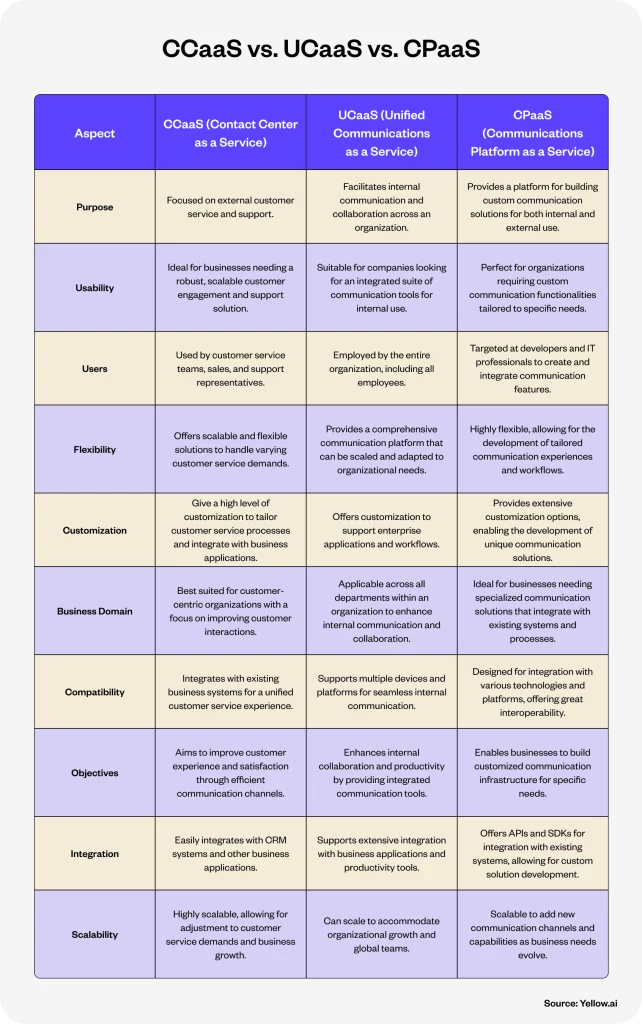
| Aspect | CCaaS (Contact Center as a Service) | UCaaS (Unified Communications as a Service) | CPaaS (Communications Platform as a Service) |
| Purpose | Focused on external customer service and support. | Facilitates internal communication and collaboration across an organization. | Provides a platform for building custom communication solutions for both internal and external use. |
| Usability | Ideal for businesses needing a robust, scalable customer engagement and support solution. | Suitable for companies looking for an integrated suite of communication tools for internal use. | Perfect for organizations requiring custom communication functionalities tailored to specific needs. |
| Users | Used by customer service teams, sales, and support representatives. | Employed by the entire organization, including all employees. | Targeted at developers and IT professionals to create and integrate communication features. |
| Flexibility | Offers scalable and flexible solutions to handle varying customer service demands. | Provides a comprehensive communication platform that can be scaled and adapted to organizational needs. | Highly flexible, allowing for the development of tailored communication experiences and workflows. |
| Customization | Give a high level of customization to tailor customer service processes and integrate with business applications. | Offers customization to support enterprise applications and workflows. | Provides extensive customization options, enabling the development of unique communication solutions. |
| Business Domain | Best suited for customer-centric organizations with a focus on improving customer interactions. | Applicable across all departments within an organization to enhance internal communication and collaboration. | Ideal for businesses needing specialized communication solutions that integrate with existing systems and processes. |
| Compatibility | Integrates with existing business systems for a unified customer service experience. | Supports multiple devices and platforms for seamless internal communication. | Designed for integration with various technologies and platforms, offering great interoperability. |
| Objectives | Aims to improve customer experience and satisfaction through efficient communication channels. | Enhances internal collaboration and productivity by providing integrated communication tools. | Enables businesses to build customized communication infrastructure for specific needs. |
| Integration | Easily integrates with CRM systems and other business applications. | Supports extensive integration with business applications and productivity tools. | Offers APIs and SDKs for integration with existing systems, allowing for custom solution development. |
| Scalability | Highly scalable, allowing for adjustment to customer service demands and business growth. | Can scale to accommodate organizational growth and global teams. | Scalable to add new communication channels and capabilities as business needs evolve. |
Top benefits of contact center as a service (CCaaS)
Contact Center as a Service (CCaaS) emerges as a game-changer for businesses striving for excellence in customer service. Let’s explore the key benefits of CCaaS and its impact on modern business operations.
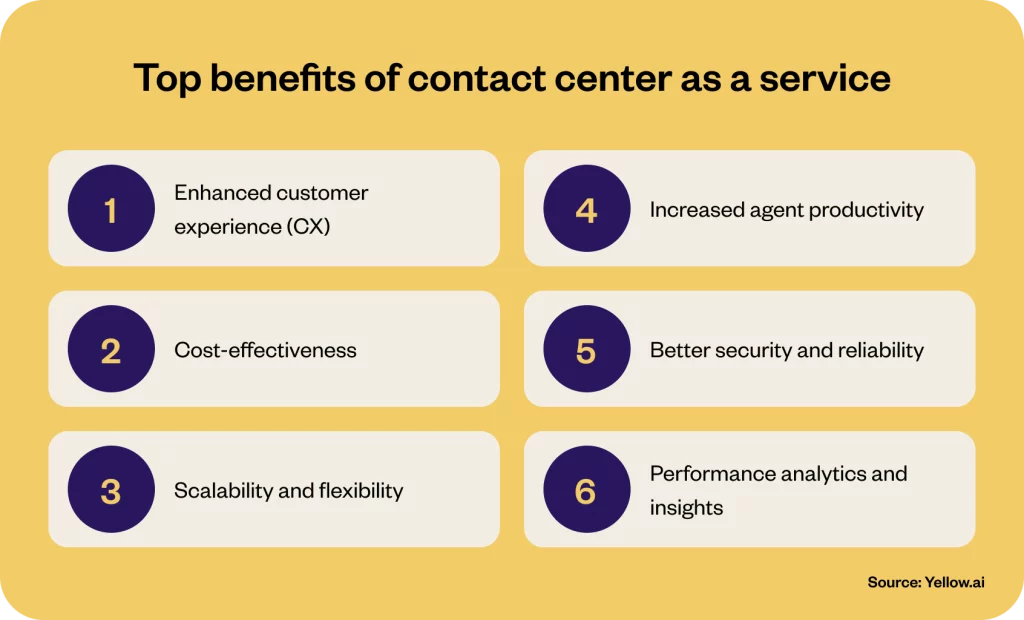
1. Enhanced customer experience (CX)
In an era where customer satisfaction dictates business success, CCaaS stands out by offering a comprehensive and personalized customer experience. Traditional contact centers often struggle with fragmented customer data, leading to disjointed service and frustrated customers. CCaaS, however, provides a unified view of customer interactions across all channels, enabling agents to deliver consistent and personalized service. This integration ensures that customers receive attentive and informed support, enhancing their overall experience and satisfaction. A unified customer experience leads to increased loyalty and repeat business.
For instance, a retail company using CCaaS can track a customer’s journey from initial inquiry through purchase and post-sale support, offering tailored recommendations and support at each step. This seamless experience not only resolves issues efficiently but also strengthens the customer’s relationship with the brand.
Ready to elevate your CX game?

2. Cost-effectiveness
CCaaS eliminates the need for substantial upfront investment in infrastructure and ongoing maintenance costs associated with traditional contact centers. By leveraging cloud technology, businesses can significantly reduce capital and operational expenditures. This pay-as-you-go model allows for more predictable budgeting and frees up capital for other strategic investments. The cost savings from CCaaS can be substantial, enabling businesses to allocate resources more effectively.
For instance, a small business can access sophisticated contact center technologies without the heavy financial burden, competing more effectively with larger companies and improving its market position.
3. Scalability and flexibility
The dynamic nature of business demands adaptability, and CCaaS offers unparalleled scalability and flexibility. Whether experiencing rapid growth or seasonal fluctuations, businesses can easily scale their contact center operations up or down without significant logistical challenges. It means being able to adjust to market demands quickly and efficiently.
For instance, an ecommerce company can scale its customer service capabilities during peak shopping seasons, like Black Friday or Christmas, ensuring they can handle increased call volumes without compromising service quality.
4. Increased agent productivity
CCaaS empowers agents with advanced tools and information, revolutionizing how they handle customer inquiries. Features like intelligent call routing, automated ticketing systems, and integrated customer databases significantly reduce the time agents spend on administrative tasks. This means agents can focus more on providing high-quality customer interactions, leading to increased productivity and improved customer satisfaction.
For example, with CCaaS, agents at a travel agency can quickly access a customer’s booking history and preferences. That makes providing personalized travel recommendations and resolving issues easier, leading to higher productivity and more successful customer outcomes.
5. Better security and reliability
In today’s digital world, security concerns and the need for reliable service are paramount. CCaaS providers recognize this and invest heavily in security measures and infrastructure reliability, offering businesses peace of mind. With data encryption, regular security updates, and disaster recovery plans, CCaaS ensures that customer data is protected and services remain uninterrupted, making it a trustworthy and reliable solution.
For example, a financial services firm using CCaaS can guarantee clients that their sensitive financial data is secure and services will be consistently available, which is crucial for maintaining trust and regulatory compliance.
6. Performance analytics and insights
In the quest for continuous improvement, CCaaS offers comprehensive analytics and reporting tools that provide insights into customer interactions and agent performance. This data-driven approach allows businesses to identify trends, measure the effectiveness of customer service strategies, and make informed decisions to enhance service quality.
For instance, a healthcare provider can use CCaaS analytics to track patient call patterns, identify common inquiries or issues, and adjust their service protocols accordingly, leading to improved patient care and operational efficiency.
How to implement contact center as a service (CCaaS)?
Implementing Contact Center as a Service (CCaaS) is a transformative step for businesses aiming to upgrade their customer service operations. Let’s explore the strategic approach to seamlessly integrate CCaaS, ensuring it aligns perfectly with your business objectives.
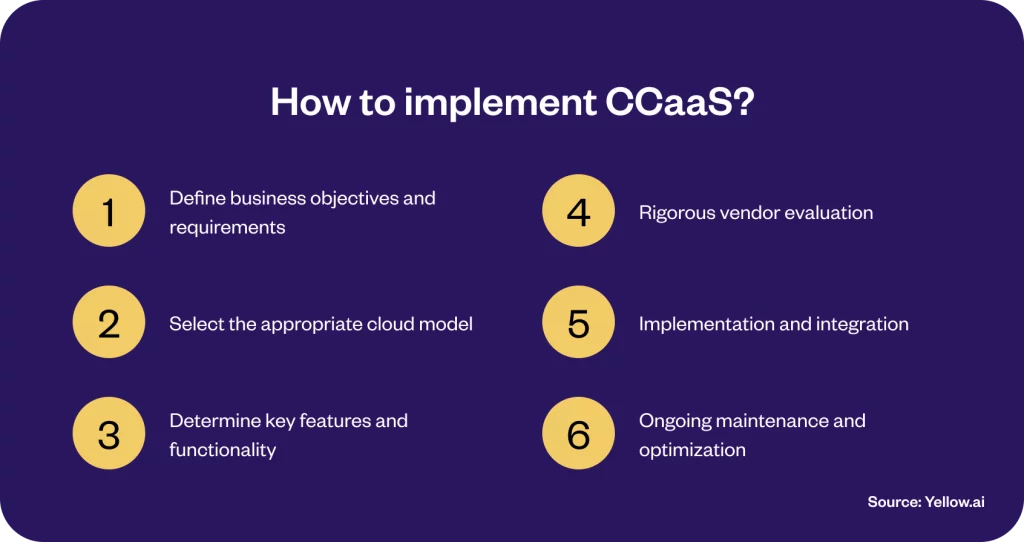
1. Define business objectives and requirements
The first step in implementing CCaaS is to understand your business’s unique needs and goals clearly. Engage with stakeholders across departments to identify key objectives, whether it’s enhancing customer experience, boosting efficiency, or complying with specific regulations.
- Identify essential metrics: Determine which metrics, such as customer satisfaction scores (CSAT), response times, and average handle time, will best measure the success of your CCaaS implementation.
- Assess needs: Evaluate the volume of interactions, preferred communication channels, and the level of sophistication required in your contact center operations.
2. Select the appropriate cloud model
Choosing the right cloud environment—public, private, or hybrid—is crucial for balancing control, cost, and compliance requirements.
- Public cloud: Ideal for businesses seeking cost-effective solutions with scalability to handle fluctuating workloads.
- Private cloud: Offers greater control and enhanced security, suitable for organizations with stringent regulatory compliance needs.
- Hybrid cloud: This type of cloud combines the benefits of public and private clouds, providing flexibility and tailored control over sensitive operations.
3. Determine key features and functionality
Prioritize features that will directly contribute to achieving your business objectives, considering integration capabilities with existing systems and the scalability of features to meet future needs.
- Integration with existing systems: Ensure the CCaaS solution can seamlessly integrate with your CRM, ERP, and other critical business applications.
- Scalability of features: Select a platform that can grow with your business, easily accommodating increased call volumes or expanding service offerings.
4. Rigorous vendor evaluation
Carefully assess potential CCaaS providers based on their reliability, service offerings, and alignment with your business requirements.
- Pricing models: Understand the different pricing structures—per user, per usage, or per event—and select the one that aligns with your operational model and budget.
- Security and compliance: Verify that the vendor meets your industry’s security standards and regulatory requirements, offering robust data protection and privacy measures.
- Performance track record: Investigate the vendor’s history of uptime and service reliability to gauge their ability to deliver consistent and effective support.
5. Implementation and integration
With a chosen vendor and clear plan, proceed to integrate CCaaS into your operations, focusing on a smooth transition for your team and customers.
- Data migration and system integration: Transfer critical data and integrate CCaaS with existing platforms, ensuring data integrity and operational continuity.
- Staff training and support: Conduct comprehensive training for your team to familiarize them with the new system, emphasizing on maximizing the features of CCaaS to improve customer interactions.
6. Ongoing maintenance and optimization
After implementation, establish a framework for continuous monitoring and improvement to maximize the value of your CCaaS investment.
- Performance monitoring: Regularly review system performance and user feedback to identify areas for improvement.
- Vendor support and updates: Maintain an active relationship with your CCaaS provider to stay updated on new features, updates, and best practices in contact center management.
Evolution of contact center as a service (CCaaS)
Tracing the evolution graph of Contact Center as a Service (CCaaS) offers a fascinating glimpse into the transformative world of customer service technology. What began as a rudimentary call-handling operation has morphed into a sophisticated, cloud-driven service model, shaping the future of customer interactions.
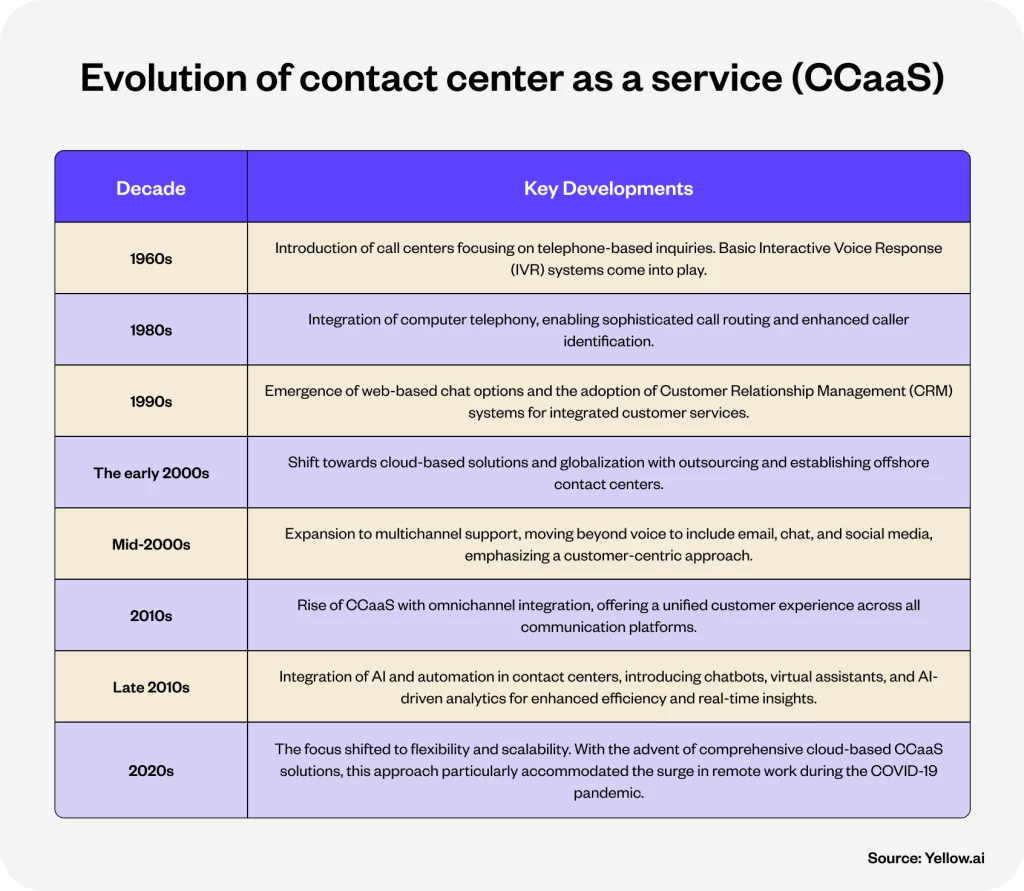
Timeline of CCaaS evolution
| Decade | Key Developments |
| 1960s | Introduction of call centers focusing on telephone-based inquiries. Basic Interactive Voice Response (IVR) systems come into play. |
| 1980s | Integration of computer telephony, enabling sophisticated call routing and enhanced caller identification. |
| 1990s | Emergence of web-based chat options and the adoption of Customer Relationship Management (CRM) systems for integrated customer services. |
| The early 2000s | Shift towards cloud-based solutions and globalization with outsourcing and establishing offshore contact centers. |
| Mid-2000s | Expansion to multichannel support, moving beyond voice to include email, chat, and social media, emphasizing a customer-centric approach. |
| 2010s | Rise of CCaaS with omnichannel integration, offering a unified customer experience across all communication platforms. |
| Late 2010s | Integration of AI and automation in contact centers, introducing chatbots, virtual assistants, and AI-driven analytics for enhanced efficiency and real-time insights. |
| 2020s | The focus shifted to flexibility and scalability. With the advent of comprehensive cloud-based CCaaS solutions, this approach particularly accommodated the surge in remote work during the COVID-19 pandemic. |
How to choose a Contact Center as a Service (CCaaS) provider?
Choosing the right Contact Center as a Service (CCaaS) provider should align strategically with your business’s vision for customer engagement. Below are key considerations for businesses that can help them choose the best CCaaS provider.
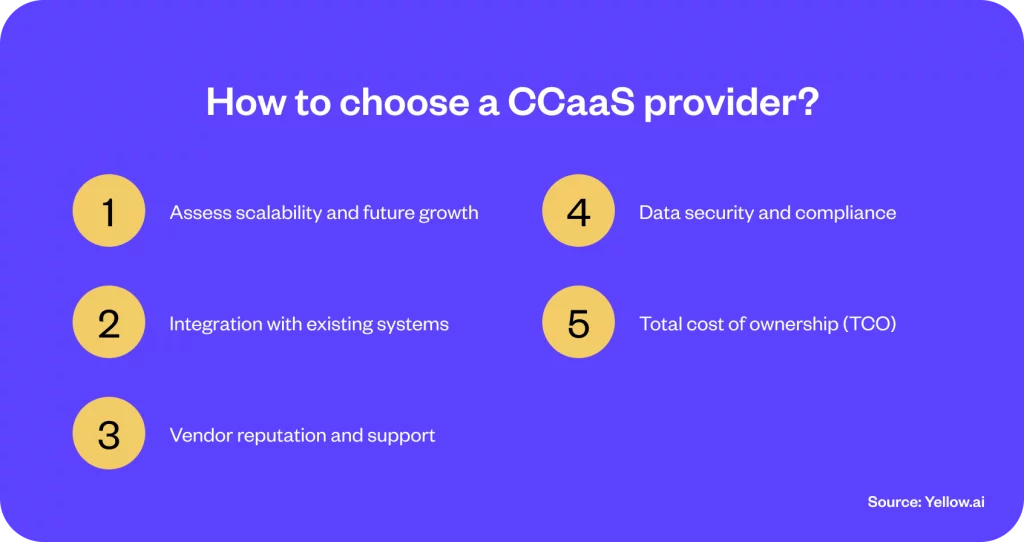
1. Assess scalability and future growth
When choosing a CCaaS provider, companies must consider their immediate needs and long-term growth potential. Scalability is crucial to accommodating expanding customer bases and evolving service offerings without the need for complete system overhauls.
Pro tip: Investigate case studies or testimonials from similar-sized enterprises in your industry that have successfully scaled using the CCaaS platform to ensure they can grow with your business.
2. Integration with existing systems
Integration capabilities are pivotal for ensuring the CCaaS platform works harmoniously with your existing business systems, such as CRM, ERP, and other tech tools, to maintain data consistency and streamline operations.
Pro tip: Conduct thorough integration testing and check for compatibility with your current tech stack to avoid potential operational disruptions and ensure a seamless data flow across systems.
3. Vendor reputation and support
A provider’s market reputation and the level of support offered are vital factors. Reliable customer support and a strong service track record are indicators of a vendor’s ability to deliver consistent, quality service.
Pro tip: Explore independent review platforms and analyst sites like G2, Forrester, or Gartner to gauge customer feedback and understand the provider’s strengths and weaknesses from existing users.
4. Data security and compliance
With increasing data breaches and cyber threats, robust security measures are non-negotiable. The chosen CCaaS platform must adhere to stringent security protocols and compliance standards relevant to your industry.
Pro tip: Inquire about the provider’s security practices, compliance certifications, and encryption methods to ensure they meet your data protection requirements.
5. Technological innovation and platform features
Choosing a CCaaS provider that leverages the latest technologies – such as AI – is not just advantageous—it’s essential for gaining a competitive edge. AI can enhance customer interactions dramatically while ensuring multifold ROI, through smarter automation, predictive analytics, and personalized service, transforming customer support into a strategic advantage.
Pro tip: Examine how the provider incorporates AI and other advanced technologies into their platform. Evaluate their track record as an industry leader and check if their solutions are enterprise-ready, ensuring they can support large-scale operations and complex requirements. Look for evidence of continuous innovation and their commitment to staying at the forefront of technology trends.
6. Availability of professional services
Assess the provider’s offering of professional services, which can include implementation support, ongoing optimization, and dedicated account management. These services are critical for ensuring successful deployment and continuous improvement of the CCaaS solution.
Pro tip: Investigate whether the provider has a dedicated professional services team. Inquire about their experience, the scope of services offered, and how they collaborate with clients to enhance system performance and user satisfaction over time.
The final thoughts on (CCaaS)
Contact Center as a Service (CCaaS) is not just a technological shift but a strategic evolution for businesses prioritizing customer engagement and service excellence. Its flexibility, scalability, and advanced features are shaping a future where businesses can seamlessly connect with customers, offering personalized and efficient service across various channels.
In this transformative era, partners like Yellow.ai emerge as catalysts, enabling organizations to leverage the full potential of CCaaS. With their innovative solutions, businesses can meet the current demands of customer service and also anticipate future trends, ensuring a sustainable and customer-centric growth trajectory.
Frequently asked questions (FAQs)
Why use a contact center as a service?
Using a contact center as a service offers numerous benefits, including reduced overhead costs, improved scalability, and access to advanced features like AI-driven analytics and omnichannel support. It enables businesses to provide a seamless and personalized customer experience while efficiently managing resources and adapting to changing market demands.
What is an example of a CCaaS?
An example of CCaaS is a cloud-based platform that allows a retail company to manage customer interactions across phone, email, chat, and social media from a single interface. This integrated approach helps the company deliver consistent and personalized customer service, track interactions, and analyze customer feedback to improve services.
What are the components of CCaaS?
Key components of CCaaS include omnichannel communication capabilities, AI-powered analytics and automation, real-time reporting and insights, customer relationship management (CRM) integration, and scalable infrastructure. These elements work together to optimize customer service operations and enhance the overall customer experience.
How do I deploy CCaaS?
To implement CCaaS, first, clearly define what your business aims to achieve with the service. Choose a provider whose offerings match your goals and integrate their solution into your current systems. Ensure your team is well-trained to maximize the platform’s capabilities. Regularly review and fine-tune the setup to align with your evolving business requirements and customer expectations.






















